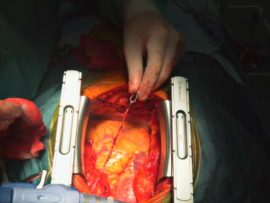Abstract Objectives: Extracorporeal lung support is currently used in the treatment of patients with severe respiratory failure until organ recovery and as a bridge to further therapeutic modalities. The aim..
Read MoreAbstract Background: Glucose–insulin–potassium (GIK) administration during cardiac surgery inconsistently improves myocardial function, perhaps because hyperglycemia negates the beneficial effects of GIK. The hyperinsulinemic normoglycemic clamp (HNC) technique may better enhance..
Read MoreAbstract Excessive haemodilution and the resulting anaemia during CPB is accompanied by a decrease in the total arterial oxygen content, which may impair tissue oxygen delivery. Hyperoxic ventilation has been..
Read MoreAbstract Objective induces in the small . One reason for this damage is a perfusion shift from the muscular toward the mucosal layer. This study investigated the effect of this perfusion shift..
Read MoreAbstract Background Peritoneal carcinomatosis (PC) results from the secondary spread of many intraabdominal tumour types, such as colorectal malignancy (colorectal cancer, CRC), disseminated peritoneal adenomucinosis (DPAM), appendiceal cancer, ovarian carcinoma,..
Read MoreAbstract Widespread use of clinical checklists is relatively new to health care. Anesthesiology has borrowed lessons from aviation safety since the late 1970s, but checklists only reached a tipping point..
Read MoreAbstract Rationale: Recent pediatric studies suggest a survival benefit exists for higher-volume extracorporeal membrane oxygenation (ECMO) centers. Objectives: To determine if higher annual ECMO patient volume is associated with lower..
Read MoreAbstract Background: Postoperative delirium is common in patients recovering from cardiac surgery. Tight glucose control has been shown to reduce mortality and morbidity. Therefore, the authors sought to determine the..
Read MoreAbstract This discussion paper presents proposed recommendations for in the Australasian clinical setting based on underlying evidence-based principles and an understanding of local factors which may limit the provision of ideal..
Read MoreAbstract , a , has recently emerged as a valuable agent in the peri-operative management of cardiac surgery patients. Levosimendan is a calcium-sensitising ionodilator. By binding to C and reducing its co-efficient, it..
Read MoreAbstract Rationale: We developed an innovative, minimally invasive, highly efficient extracorporeal CO2 removal (ECCO2R) technique called respiratory electrodialysis (R-ED). Objectives: To evaluate the efficacy of R-ED in controlling ventilation compared with..
Read MoreAbstract Background The impact of transfusion of aged red blood cells (RBCs) on the outcome after (CABG) is controversial. This issue has been investigated in the present study. Materials and methods..
Read MoreAbstract Background: Coronary artery bypass surgery is the most commonly performed cardiac operation and approximately 40-70% of patients require a blood transfusion despite improvements in cardiac surgical techniques. Some preventive..
Read MoreAbstract Objective: To assess whether preoperative versus intraoperative insertion of an intra-aortic balloon pump is associated with lower 30-day mortality or reduced length of hospital stay among patients who had..
Read MoreAbstract We conducted a prospective, observational study to determine the incidence of feeding intolerance (FI) within 7 d of initiating enteral nutrition (EN) in patients undergoing cardiopulmonary bypass (CPB) and..
Read MoreAbstract Objectives To explore the preoperative, intraoperative, and postoperative dynamics of heparin-binding protein (HBP) in cardiothoracic surgery. Design This was a prospective, observational study. Setting The study was conducted at..
Read MoreAbstract Objective To assess whether the administration of the ultra-short–acting β-blocker esmolol in cardiac surgery could have a cardioprotective effect that translates into improved postoperative outcomes. Design Single-center, double-blinded, parallel-group..
Read MoreAbstract Purpose of review To review pathophysiological pathways of immune system response to infections, which may justify mediators removal by extracorporeal blood purification therapies (EBPTs) in critically ill septic patients...
Read MoreAbstract This review wants to give an overview to most of the controversial fields in the clinical therapeutic assistance in neonatal and pediatric general and cardiothoracic surgery in anaesthesia and..
Read MoreAbstract The age of (EC) in and the when transfusing long-term-stored EC are highly controversial issues. Whereas the definition of a short-term-stored EC or a long-term-stored EC is unclear in clinical trials, data..
Read MoreAbstract Acute kidney injury (AKI) is a frequent complication after cardiopulmonary bypass, but early detection of postoperative AKI remains challenging. Protein biomarkers predict AKI excellently in homogeneous cohorts but are..
Read MoreAbstract Background: Previous work has demonstrated paradoxical increases in cerebral oxygen saturation (ScO2) as blood pressure decreases and paradoxical decreases in ScO2 as blood pressure increases. It has been suggested that..
Read MoreAbstract To facilitate venoarterial extracorporeal membrane oxygenation (ECMO) insertion for cardiogenic shock, we recently adopted a strategy of using a 15F arterial cannula in all patients, rather than 1 designed..
Read MoreAbstract This is a review of the University of Michigan experience with extracorporeal life support (ECLS) also known as extracorporeal membrane oxygenation (ECMO). Two thousand patients were managed with ECMO..
Read MoreAbstract OBJECTIVES Although antegrade selective cerebral perfusion (ASCP) provides good brain protection during aortic arch surgery, the issue of distal organ protection during circulatory arrest remains to be clarified. The..
Read MoreAbstract Diagnosis of heparin induced thrombocytopenia (HIT) is not always easy, especially when a confirmatory functional test is not available. In most cases the diagnosis relies on the combination of..
Read MoreAbstract Objective: Intra-operative cell salvage (CS) was reported to be ineffective, safe and not cost-effective in low-bleeding-risk cardiac surgery with cardiopulmonary bypass (CPB), but studies in high-bleeding-risk cardiac surgery are limited...
Read MoreAbstract The prediction of bleeding risk in cardiopulmonary bypass (CPB) patients plays a vital role in their postoperative management. Therefore, an artificial neural network (ANN) to analyze intra-operative laboratory data..
Read MoreAbstract Background The Organ Care System is the only clinical platform for ex-vivo perfusion of human donor hearts. The system preserves the donor heart in a warm beating state during..
Read MoreAbstract Heart failure has become a global epidemic. For advanced heart failure, a broad assortment of device options have been introduced for both acute and prolonged intervals of assistance. Durable implantable (VADs)..
Read More

















